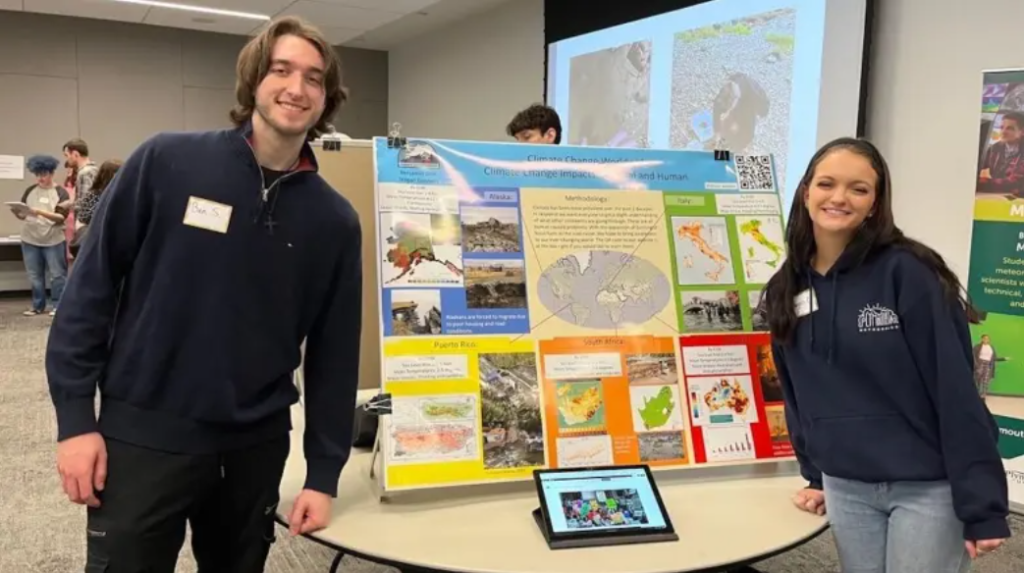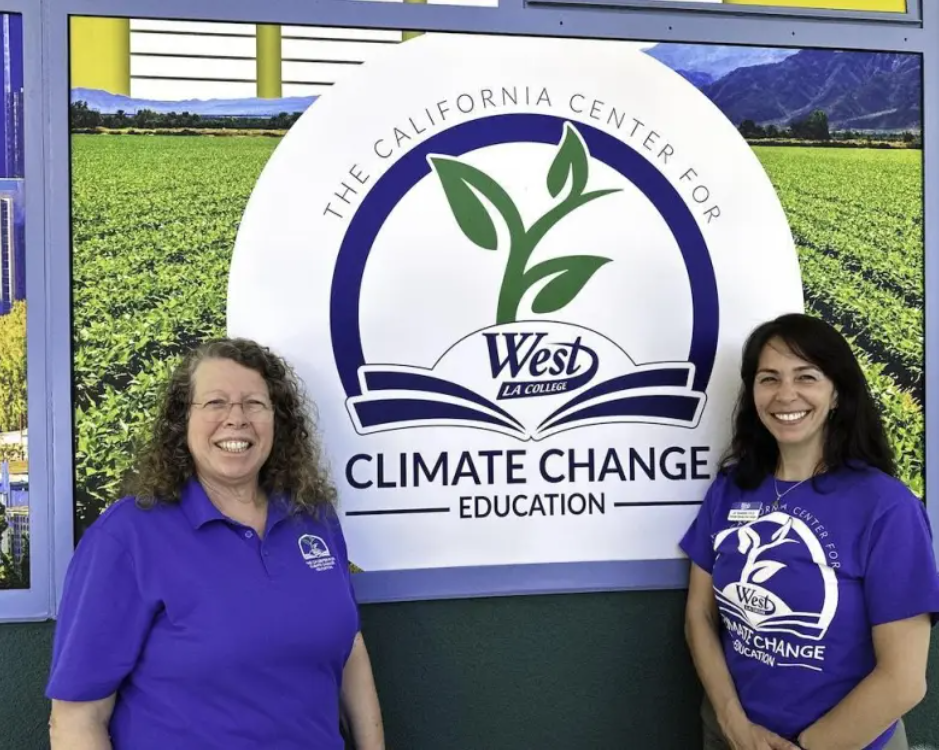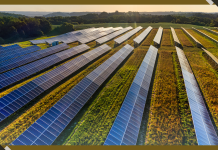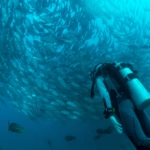Written by: Bob Henson
When Teagan Connelly was in high school in Connecticut, climate change grabbed her attention — and promptly threw her into despair. “While some people are in the denying stage of accepting climate change, I was in the ‘Oh no, the world is ending and we are all going to die’ stage,” she recalled.
That changed after she arrived in 2019 at New Hampshire’s Plymouth State University, drawn there by the school’s well-known meteorology program. In the spring of her first year, she took a climatology course from research associate professor Eric Kelsey in which groups delved into climate-related issues and presented them to their classmates with an eye toward finding solutions.
“This was the start of my love for solving the climate crisis,” Connelly wrote in an email to Yale Climate Connections. “Hearing the ideas of my other classmates and having everyone bounce off of each other with (actually really decent) solutions was inspiring.”
Plymouth State is among a handful of campuses — including at least one community college — that are going beyond long-standing programs in atmospheric science and environmental studies to craft majors and minors. Typically called “climate studies” or a variant, these new degrees are centered on climate-change issues yet broader than a traditional science-centric program. Although only a small number of students have entered such majors so far, they’re already landing internships and jobs in organizations ranging from a water quality lab to the National Renewable Energy Laboratory.

A field of study much bigger than climate science
In spring 2023, Connelly became the first student at Plymouth State to graduate with a bachelor’s of science in climate studies. The major has grown from a 2020 proposal championed by meteorology professors Lourdes Aviles and Eric Hoffman to become one of the nation’s frontier attempts at making climate a truly interdisciplinary subject of study.
“We need people who are knowledgeable about climate, but we don’t need only scientists,” said Aviles, an expert in tropical meteorology and air quality whose own diverse endeavors include an award-winning book on a famed New England hurricane, “Taken by Storm, 1938.”
As stated in the proposal to create Plymouth State’s major, “Our design acknowledges that the problem of climate change goes well beyond basic and even applied science and that in order to appropriately solve current and future problems caused by its effects, a highly interdisciplinary approach and experts with many different types of skills are needed.”
The Plymouth State proposal was led by faculty from the meteorology and environmental science and policy departments. Along the way, they consulted with colleagues from an eye-poppingly broad set of other specialties: art, biology, business, communication, computer science, English, environmental planning, environmental science, foreign languages, geography, GIS, math, political science, and sociology.
The push for a climate science degree at Plymouth State dovetailed with the campus’s growing interest in developing disciplinary-spanning cluster programs. In fact, climate studies emerged as the school’s first such program, according to Hoffman: “The idea is that it’s interdisciplinary, it’s open, and it has practical, real-life experiences for students. Open as in accessible — you don’t have to buy textbooks — and project-based, with significant experiences.”
Students in the major must take 23 core credits across atmospheric, climate, and environmental science and communication, along with seven math credits and three to four technical skills credits, plus 24-32 credits in one or more interdisciplinary focus areas to be chosen by the student and their adviser. An intro climate science course is bookended by a senior capstone course where students blend their climate knowledge and interdisciplinary interests.
Connelly was energized by courses on sustainability and climate change mitigation and adaptation. “You would think learning about climate effects would only add to the ‘doomerism,’ but it didn’t,” she said. “While not every college student can say this, I was so excited to go to class every day because I was learning about things I was actually interested in.”
Ricardo Nogueira joined Plymouth State as coordinator of climate studies in January after a decade at Georgia State University, where he won plaudits for his use of technology. “I wanted to go to a smaller school where my interactions with students would be more direct,” Nogueira said. A geographer by training, Nogueira taught the capstone climate studies course this spring, guiding Connelly and classmate Ben Sitar as they developed a poster and website on their work.
Connelly is now on Cape Cod at the Barnstable County Health and Environment Department’s water quality lab, where she segued into a permanent position after a summer job. She hopes to eventually work at the Woods Hole Oceanographic Institute on carbon-ocean interactions, but for now she’s enjoying the on-the-job learning experience. “Overall, switching my major to climate studies was one of the best decisions I have made,” Connelly said.
How many climate studies programs are out there? Unclear.
There’s precious little data on how many students there are in climate studies programs nationwide — or even how many such programs exist. Climate science itself has interdisciplinary roots: It grew out of both atmospheric science and Earth or environmental science.
By the 2000s, climate change was gaining more prominence as a topic of interest within environmental studies. Meanwhile, several master’s programs expanded beyond STEM, including a pioneering master of arts degree in climate and society at Columbia University that’s been folded into the new Columbia Climate School, which is serving up a wide array of programs from K-12 to Ph.D. levels. One recent informal census found 23 master’s programs that paired climate with other topics, including energy policy, environmental law, justice, and sustainability.
The National Center for Education Statistics added “climate science” as a trackable major in 2020. It’s unclear whether undergraduate climate studies programs will end up in this bucket, which is part of a science-focused category the center calls “multi/interdisciplinary studies.”
Atmospheric scientist John Knox, the Josiah Meigs Distinguished Teaching Professor at the University of Georgia, has long worked to track enrollments in meteorology and atmospheric science, especially since the leading project to gather such data — a collaboration between the American Meteorological Society and the University Corporation for Atmospheric Research — fell by the wayside in the mid-2000s.
In an article published early this year in the Bulletin of the American Meteorological Society, Knox noted an apparent downturn in undergraduate enrollments across the atmospheric sciences over the past decade. At the same time, he added, “There seems to have been growth in the number of climate science majors nationally since the late 2010s, and so future studies will need to account for the broadening of our discipline at the undergraduate level.”
Knox said he hopes that students in the growing crop of climate studies programs will get enough exposure to climate science to solidly undergird careers that can go well beyond the STEM world. “I expect there’ll be a range of math/science rigor,” he said.
Three campus domains join to embrace climate studies at Vanderbilt
Another of the nation’s embryonic degrees in climate studies, this one a B.A., is growing quickly at Vanderbilt University in Nashville. A standout feature of the program is participation from the natural sciences, social sciences, and humanities. “As far as we know, it is the country’s first interdisciplinary major in climate studies with courses from all three areas of the curriculum,” said David Hess. A professor of sociology, Hess also serves as director of Vanderbilt’s Program in Climate and Environmental Studies.
The interdisciplinary triad at the heart of Vanderbilt’s climate studies program was part of the vision of former Dean John Geer, who had launched a grand challenge initiative for climate change and society. Since 2011, the university had been offering a minor in environmental and sustainability studies. Co-chairing the faculty committee that developed the new climate studies major were Geer; Jonathan Gilligan, a professor of Earth and environmental sciences and civil and environmental engineering; and Betsey Robinson, an associate professor of art and architecture history.
Robinson stressed the engagement of both faculty and students in the new major and the noteworthy inclusion of humanities as a key element. “There is no other program in the country approaching climate in this way,” she said. “Humanities scholars have important skills and perspectives to offer. Relevant courses offer opportunities to look at climate, environment, and human attitudes across time and around the world, in reality and in the imaginary.”
Requirements for the major include an interdisciplinary introductory course, a climate science course, two methods-and-practices courses, and at least one course each in climate and environmental studies from the social sciences, natural sciences, and humanities.
As of fall 2023, a year after its launch, Vanderbilt’s climate studies program has 31 officially declared majors, including 26 who are double majors, according to Zdravka Tzankova, an associate professor of the practice of climate studies and the director of undergraduate climate studies. Among the double majors, half are combining climate studies with another social science major. Another quarter are pairing the major with engineering, about 15 percent with Earth and environmental science, and 11 percent with humanities.
“The vast majority of students are interested in advancing positive social change through practitioner work and actionable research,” Tzankova said. “A number of students are interested in working in the public and nonprofit sectors, and many are interested in climate, equity, and sustainability careers in the private sector.”
Aaditi Lele was spreading the word on climate change even before she came to Vanderbilt, writing on the topic for her student newspaper as well as the youth-led Defiant Movement Magazine while in high school in Ohio. She’s now the policy director at Zero Hour, a youth-led climate justice nonprofit, as she works on a double major in climate studies and political science and a minor in South Asian studies — potentially graduating at the end of her junior year. This summer Lele worked as a legal and research intern with the Earth Law Center, focusing on a lawsuit in Washington related to timber auctions on public lands, and in July an essay cowritten by Lele with Zero Hour colleague Sena Wazer appeared in The Nation.
“I knew coming into college that I wanted to incorporate environmental studies into a policy/politics education, but I wasn’t sure what that was going to look like,” Lele said. “I didn’t come from a STEM background, but I wanted a program where I could get enough of a science education to talk about climate change in a really informed way.” One of her favorite courses so far was a climate journalism class in which students analyzed articles, identifying what worked and what didn’t, with a focus on Tennessee.
“This program has been pretty much the perfect academic fit for me,” Lele said. “I’ve seen people combine climate studies with so many academic areas. It’s exciting to see people taking it in all directions.”
Jason Hwong, a double major in climate studies and mechanical engineering, spent this past summer working as an intern at the National Renewable Energy Laboratory in Colorado, where he delved into how advanced charge protocols could help speed the process of “refueling” electric vehicles. “We’re hoping to encourage adoption of EVs by making the charging experience faster and therefore closer to the experience of refilling a gas car,” Hwong explained.
After Vanderbilt, Hwong expects to move into a career in engineering, perhaps materials science. With wind turbine and solar panel technology already well advanced, he finds the evolving world of battery storage “super interesting.” But Hwong’s climate science major is also feeding his broader interests, including the merits and pitfalls of carbon offsets and other policy levers — “not just ‘Here’s what the tech is,’ but its impact on society.”
Samuel Lu, who is majoring in elementary education and human and organizational development as well as climate studies, plans to teach elementary school after he graduates.
“As someone who cares strongly about children, it’s impossible not to view climate change as the greatest threat to their ability to thrive,” Lu said. “I’ve always felt a strong pull towards the issues of justice and equity associated with global warming. The climate studies major at Vandy is perfect for this.
“Having my justice-oriented interest of climate change validated as academically worthwhile is incredibly rewarding and encourages myself and others to do the academic work necessary to supporting the fight against climate change.”
California brings climate studies to community college
Along with four-year campuses, community colleges are turning to climate studies — particularly in California, where the California Center for Climate Change Education was established in 2022 with $5 million in state funding and $1.3 million in federal support. The center is based at West Los Angeles College in Culver City, a diverse urban campus where a program in climate and environmental studies launched in 2018 is gaining traction.
Jo Tavares, an oceanographer now completing her doctorate at the University of California, Irvine, came on board to direct the new center in April. Both the center and the program were championed by West Los Angeles College president James Limbaugh, Tavares said: “It’s commendable what President Limbaugh has been able to accomplish considering what a small college we are.”
The college had offered environmental science classes for years, and many of those students were keenly interested in climate, said Vered Mirmovitch, an associate professor of biological sciences. She started an environment club in 2015 that survived the turmoil of the pandemic years through regular Zoom meetings. Those online meetings continue, along with twice-weekly in-person gatherings at an organic garden maintained by the students. The group has also carried out beach cleanups, taken hikes, and planted native bushes and trees in the Baldwin Hills.
“The students feel good and energize each other about climate change and climate justice,” said Mirmovitch. “We have to do something to channel anxiety into action on the way to a solution.”
The college’s associate of arts degree in climate change and environmental studies — billed as the first of its kind in the nation at the community college level — saw one graduate each in 2020 and 2021, Mirmovitch said. One completed her bachelor’s at the University of California, Davis, in environmental science and management, while the other is majoring in forestry at Cal Poly/Humboldt State University.

“We helped mentor and guide the students towards a meaningful path based on their environmental interest,” Mirmovitch said.
There were three graduates each in spring 2022 and 2023. Those graduates are “amazing, surprising, [with an] integrated understanding of climate — the complete notion of what this crisis is,” Tavares said. ”When you talk to them, they can clearly articulate that the causes of climate change are associated with broader issues affecting societies all over the world.”
Marilyn Chavez, an Indigenous student from Guatemala who is pairing a career interest in health sciences with a pursuit of climate-related studies, told Laist.com that West Los Angeles College has helped her to forge connections between the two: “What I’ve learned recently here is that despite what career path you take, environmental education is so important because it’s something you can apply to every field.”
The new center at the college, which will serve all nine campuses of the sprawling Los Angeles Community College District, is well positioned to support this decade’s surge in climate-related infrastructure funding as it trains practitioners in clean energy and climate technology. “Everyone is celebrating the news that President Biden is creating the American Climate Corps,” Tavares said. “That’s a big deal for the youth movement, and it got cut out when the Inflation Reduction Act was created.”
On October 24-26, 2023, the center is to sponsor an inaugural Climate Action Palooza, emphasizing youth activism, green-collar job training, and education. “We’re really focused on helping students to become champions for their community by teaching them how to access funding, write grant proposals, connect with the business partners to do something tangible: EV chargers, trees to combat the heat island effect,” Tavares said.
“We’re surviving an urban environment — we have to adjust.”
This article originally appeared on Yale Climate Connections







